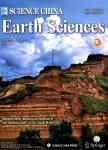Growth structures and growth strata of the Qianjiadian Basin in the western Yanshan fold and thrust belt, North China
Growth structures and growth strata of the Qianjiadian Basin in the western Yanshan fold and thrust belt, North China作者机构:State Key Laboratory of Geological Processes and Mineral Resources and School of Geosciences and Resources China University of Geosciences (Beijing)
出 版 物:《Science China Earth Sciences》 (中国科学(地球科学英文版))
年 卷 期:2019年第62卷第7期
页 面:1092-1109页
核心收录:
学科分类:07[理学] 0708[理学-地球物理学] 0704[理学-天文学]
基 金:supported by the National Key Research and Development Project (Grant No. 2017YFC0601405) the National Natural Science Foundation of China (Grant Nos. 41572189 & 41820104004) the Strategic Priority Research Program of the Chinese Academy of Sciences (Grant No. XDB18030604)
主 题:Yanshan fold and thrust belt Qianjiadian Basin Tuchengzi Formation Growth structure Growth strata Izanagi Plate
摘 要:The northwestward subduction of the Izanagi Plate beneath the eastern Eurasian Plate during the Late Mesozoic caused a series of compressional deformation events in the Yanshan fold and thrust belt(YFTB), but the tectonic deformation timing, tectonic properties and relationship between tectonic uplift and sediment accumulation in the intermontane basins continue to be debated. For this reason, the sedimentology, sediment provenance, and basin structure of the Qianjiadian Basin(QJB) in the northern Beijing region during the Late Jurassic and Early Cretaceous were studied in detail. The results suggest that a fault-propagation fold-type(FPFT) growth structure and growth strata developed on the western edge of the QJB and that the top part of Member 2 and Member 3 of the Tuchengzi Formation are growth strata controlled by the limb rotation mechanism. In two small thrust faults in the QJB, the Mesoproterozoic Xiamaling Formation is thrust over the Tuchengzi Formation, and these faults may have controlled the development of the fault-bend fold-type growth strata. An analysis of the source-to-sink process suggests that the hanging wall succession of the Shangyi-Pingquan fault(SPF) was the main source area of the Late Jurassic to early Early Cretaceous strata in the QJB. A zircon206 Pb/238 U age of 140.8±2.4 Ma for the volcanic rocks at the bottom of the FPFT growth strata represents the timing of the initiation of FPFT growth structure development. The discovery of the FPFT growth structure and growth strata in the QJB indicate that the QJB was an intermontane flexural basin controlled by fold and thrust structures during the early Early Cretaceous. Near the E-W-trending SPF, the NE-SW-trending Qianjiadian thrust fault(QJTF) and two small intrabasinal thrust faults may constitute a unified right-lateral strike-slip system that formed in response to the northwestward flat subduction of the Izanagi Plate beneath the East Asian continent during the Jurassic-Early Cretaceous.



